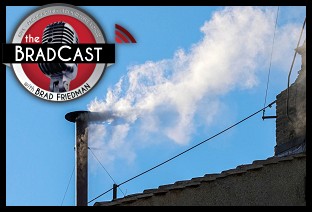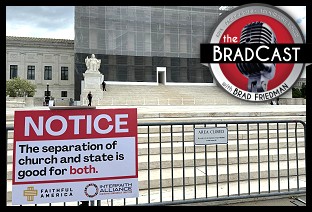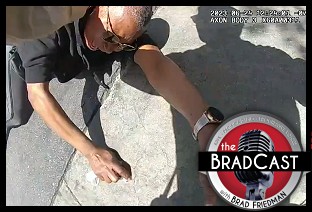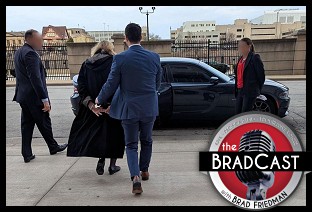Guest Blogged by Alan Breslauer
 On Saturday, there was a death "surge" in Iraq as at least 25 U.S. troops were killed on a single day in the worst one-day death toll for our troops since the start of the War.
On Saturday, there was a death "surge" in Iraq as at least 25 U.S. troops were killed on a single day in the worst one-day death toll for our troops since the start of the War.
Meanwhile, as Bush prepares to serve up another 21,500 American troops to Iraq, it's worth taking a look at who the hell came up with the "augmentation" plan in the first place, what it said before the Bush spin machine grabbed hold of it, and what the plan's author has had to say since Bush revealed it to the country on January 10, 2007.
According to Fred Barnes, Fox "News" perennial and editor of The Weekly Standard and as confirmed by the BBC, Washington Post and The Economist, Bush's new and improved plan for Iraq is based on a 50-page report written by retired General Jack Keane and Frederick Kagan, a "military academic" at the American Enterprise Institute (AEI). The report does, in fact, read much like Bush's proposal. With one small exception. As Barnes points out, the Keane/Kagan plan originally "envision[ed] a temporary addition of 50,000 troops".
With that in mind, here are some excerpts from the report, a television appearance and other media authored by Frederick Kagan over the last two months --- beginning before last November's election, well prior to Bush's announcement of the new scheme --- along with a couple of guest appearances by Surge Master Bill Kristol...
November 1, 2006
Kagan on NewsHour with Jim Lehrer (Ray Suarez hosting), PBS:
November 27, 2006
Kagan and Bill Kristol lay the groundwork in The Weekly Standard for some unparalleled hypocrisy in their January 20, 2007 bashing of Senator Hillary Clinton:
December 4, 2006
Kagan in The Weekly Standard:
Almost all of the Army units not deployed or deploying to Iraq are rated not-combat ready... Two solutions: Send forces that are not as well trained as one would like, or conduct the surge itself in phases, accelerating the deployment of the troops preparing to go in in the spring and sending a follow-on wave behind them.
It is also true that deploying more forces to Iraq would require accepting greater risk elsewhere.
December 21, 2006
Kagan's opinion piece, "US Cannot Accept Defeat", runs in USA Today:
Securing the critical areas of Baghdad would require a surge of at least 35,000 more U.S. combat troops into Iraq (some would go into Anbar province and elsewhere to contain any spillover from Baghdad).
December 24, 2006
Kagan quoted by Times Online calling for 30,000 more troops:
There are now the equivalent of three brigades of US troops in Anbar. An additional two (about 10,000 troops) there would not allow the United States to clear and hold the province but would prevent insurgents fleeing the fight in Baghdad from destabilising Anbar further.
The increase in US troops cannot be short-term.
NOTE: Bush's plan calls for just 4,000 new troops in Anbar, leaving just 17,500 additional troops for Baghdad.
December 27, 2006
Kagan and Keane combine forces in an Washington Post Op-Ed:
Of all the "surge" options out there, short ones are the most dangerous. Increasing troop levels in Baghdad for three or six months would virtually ensure defeat.
It is difficult to imagine a responsible plan for getting the violence in and around Baghdad under control that could succeed with fewer than 30,000 combat troops beyond the forces already in Iraq.
The only "surge" option that makes sense is both long and large.
January 4, 2007
An interim presentation (dated December 14, 2006 on the AEI website but with the filename "20061219_ChoosingVictory" and labeled January 4, 2007 on the chart itself) contains the following which calls for an additional 31,150 combat troops to be deployed in two stages:

January 11, 2007
The final version of Kagan's AEI plan "Choosing Victory: Iraq Planning Group" seemingly calls for about 33,000 additional troops to secure parts of Baghdad:
The violence in the central areas of Iraq is now so high that few reporters venture far from the Green Zone. Consequently, events within a relatively small area of the capital now disproportionately shape the world’s perceptions of the situation in the country. It is necessary to focus on securing these areas in order to retain the American people’s support for the war and increase international support.
Any lesser force will entail a much greater risk of failure.
It is unlikely that large numbers of U.S. troops could begin to return home until much later in 2008.
Many of the proposals in this section can be summed up briefly: the nation must be put on a war footing.
*numbers added but based on figures Kagan used for BCTs and RCTs elsewhere
January 20, 2007
Kagan and Kristol show their true stripes in another article for The Weekly Standard:
There is one man who should be recommending the size of American forces in Iraq, and that is the incoming commander, General Petraeus. Neither the Bush administration nor any collection of congressmen should preempt his professional evaluation of the situation and of the forces necessary to accomplish his mission. It is foolish and absurd for politicians to propose resolutions on American troop strength in Iraq before even hearing General Petraeus's voice in the debate. And when he has spoken, Senator Clinton and her colleagues should carefully weigh the burden they will take on themselves if they dismiss his advice.
Senator Clinton's troop cap is dangerously foolish. The nonbinding resolution of disapproval Senator Biden has proposed is irresponsible.
Foolish and irresponsible? Like promoting a troop escalation level that you had previously dismissed as "dangerous", "difficult to imagine" being "responsible" and "likely to fail"? Or foolish and absurd like criticizing Senator's Clinton and Biden for thinking anyone, other than the military commander in Iraq, should determine troop levels weeks after writing that the military commander was wrong about troop levels and then promoting your own plan for more troops ad nauseam? Finally, if not arbitrary, what would you label calls for a troop surge of 50,000, 40,000, 35,000, 33,000, 31,500, 30,000 and 21,500 over two months?
It's difficult to imagine anything more foolish and irresponsible than following the KKK (Kagan, Keane and Kristol) plan in Iraq.


 'A World of Tyrants,
'A World of Tyrants, 'Green News Report' 5/22/25
'Green News Report' 5/22/25
 'Dangerous Times': Climate Scientist Warns Trump 'Censorship' Endangering Nat'l Security: 'BradCast' 5/21/25
'Dangerous Times': Climate Scientist Warns Trump 'Censorship' Endangering Nat'l Security: 'BradCast' 5/21/25 And Then They Came for Members of Congress...: 'BradCast' 5/20/25
And Then They Came for Members of Congress...: 'BradCast' 5/20/25 'Green News Report' 5/20/25
'Green News Report' 5/20/25 Appeals Court Blocks Last Route for Voters to Challenge Violations of the VRA: 'BradCast' 5/19/25
Appeals Court Blocks Last Route for Voters to Challenge Violations of the VRA: 'BradCast' 5/19/25 Sunday 'Now Hoarding' Toons
Sunday 'Now Hoarding' Toons Mad World:
Mad World: 'Green News Report' 5/15/25
'Green News Report' 5/15/25 Plane Corruption and the Future of the DOJ: 'BradCast' 5/14/25
Plane Corruption and the Future of the DOJ: 'BradCast' 5/14/25 'Deeply Evil': GOP Proposes Largest Medicaid Cuts in History: 'BradCast' 5/13/25
'Deeply Evil': GOP Proposes Largest Medicaid Cuts in History: 'BradCast' 5/13/25 'Green News Report' 5/13/25
'Green News Report' 5/13/25 And Then They Came for the Mayors...: 'BradCast' 5/12/25
And Then They Came for the Mayors...: 'BradCast' 5/12/25 Sunday 'New Guy, Old Guy' Toons
Sunday 'New Guy, Old Guy' Toons Blowing Smoke. At the Vatican and White House: 'BradCast' 5/8/25
Blowing Smoke. At the Vatican and White House: 'BradCast' 5/8/25 'Green News Report' 5/8/25
'Green News Report' 5/8/25 SCOTUS Weighs Public Funding of Religious Schools: 'BradCast' 5/7/25
SCOTUS Weighs Public Funding of Religious Schools: 'BradCast' 5/7/25 Trump Judge Blocks NC GOP Theft of 2024 Supreme Court Seat: 'BradCast' 5/6/25
Trump Judge Blocks NC GOP Theft of 2024 Supreme Court Seat: 'BradCast' 5/6/25 Prosecutors Quit After U.S Attny Strikes Deal With Felon Cop: 'BradCast' 5/5/25
Prosecutors Quit After U.S Attny Strikes Deal With Felon Cop: 'BradCast' 5/5/25 Trump Losing Streak Continues into SECOND Hundred Days: 'BradCast' 5/1/25
Trump Losing Streak Continues into SECOND Hundred Days: 'BradCast' 5/1/25 100 Daze (w/ Digby and Driftglass): 'BradCast' 4/30/25
100 Daze (w/ Digby and Driftglass): 'BradCast' 4/30/25 Campaign to 'Impeach Trump Again' Gains Fresh Momentum: 'BradCast' 4/29/25
Campaign to 'Impeach Trump Again' Gains Fresh Momentum: 'BradCast' 4/29/25 And Then They Came for the Judges...: 'BradCast' 4/28/25
And Then They Came for the Judges...: 'BradCast' 4/28/25 Trump EPA Guts Enviro Justice Office: 'BradCast' 4/24/25
Trump EPA Guts Enviro Justice Office: 'BradCast' 4/24/25
 VA GOP VOTER REG FRAUDSTER OFF HOOK
VA GOP VOTER REG FRAUDSTER OFF HOOK Criminal GOP Voter Registration Fraud Probe Expanding in VA
Criminal GOP Voter Registration Fraud Probe Expanding in VA DOJ PROBE SOUGHT AFTER VA ARREST
DOJ PROBE SOUGHT AFTER VA ARREST Arrest in VA: GOP Voter Reg Scandal Widens
Arrest in VA: GOP Voter Reg Scandal Widens ALL TOGETHER: ROVE, SPROUL, KOCHS, RNC
ALL TOGETHER: ROVE, SPROUL, KOCHS, RNC LATimes: RNC's 'Fired' Sproul Working for Repubs in 'as Many as 30 States'
LATimes: RNC's 'Fired' Sproul Working for Repubs in 'as Many as 30 States' 'Fired' Sproul Group 'Cloned', Still Working for Republicans in At Least 10 States
'Fired' Sproul Group 'Cloned', Still Working for Republicans in At Least 10 States FINALLY: FOX ON GOP REG FRAUD SCANDAL
FINALLY: FOX ON GOP REG FRAUD SCANDAL COLORADO FOLLOWS FLORIDA WITH GOP CRIMINAL INVESTIGATION
COLORADO FOLLOWS FLORIDA WITH GOP CRIMINAL INVESTIGATION CRIMINAL PROBE LAUNCHED INTO GOP VOTER REGISTRATION FRAUD SCANDAL IN FL
CRIMINAL PROBE LAUNCHED INTO GOP VOTER REGISTRATION FRAUD SCANDAL IN FL Brad Breaks PA Photo ID & GOP Registration Fraud Scandal News on Hartmann TV
Brad Breaks PA Photo ID & GOP Registration Fraud Scandal News on Hartmann TV  CAUGHT ON TAPE: COORDINATED NATIONWIDE GOP VOTER REG SCAM
CAUGHT ON TAPE: COORDINATED NATIONWIDE GOP VOTER REG SCAM CRIMINAL ELECTION FRAUD COMPLAINT FILED AGAINST GOP 'FRAUD' FIRM
CRIMINAL ELECTION FRAUD COMPLAINT FILED AGAINST GOP 'FRAUD' FIRM RICK SCOTT GETS ROLLED IN GOP REGISTRATION FRAUD SCANDAL
RICK SCOTT GETS ROLLED IN GOP REGISTRATION FRAUD SCANDAL VIDEO: Brad Breaks GOP Reg Fraud Scandal on Hartmann TV
VIDEO: Brad Breaks GOP Reg Fraud Scandal on Hartmann TV RNC FIRES NATIONAL VOTER REGISTRATION FIRM FOR FRAUD
RNC FIRES NATIONAL VOTER REGISTRATION FIRM FOR FRAUD EXCLUSIVE: Intvw w/ FL Official Who First Discovered GOP Reg Fraud
EXCLUSIVE: Intvw w/ FL Official Who First Discovered GOP Reg Fraud GOP REGISTRATION FRAUD FOUND IN FL
GOP REGISTRATION FRAUD FOUND IN FL

































